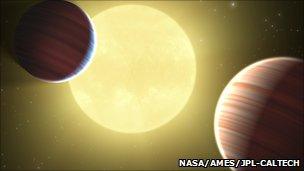Kepler spies Saturn-sized worlds
- Published

An artist's impression of Kepler-9b and 9c - two Saturn-sized objects
The US space agency's Kepler planet-hunter has spied a star that has two Saturn-sized objects circling it.
Astronomers say they cannot be sure just yet but there may be a third, more Earth-sized planet present as well.
Follow-up studies were now trying to confirm this suspicion, Matthew Holman and colleagues told Science magazine.
The Kepler telescope was launched last year to identify planets by looking for periodic dips in light as objects pass in front of stars.
It is equipped with the largest camera ever put in space.
The mission has so far amassed hundreds of these transit events but definitive statements about the discovery of new planets beyond our Solar System - so-called exoplanets - can only be made after many careful repeat observations.
The two Saturn-sized objects announced through the journal's online publication tool, Science Express, are the result of seven months of detailed analysis.
In step
Not only have they been seen in the Kepler data but their properties have also been probed by the Keck ground-based telescope facility in Hawaii.
They are referred to simply as Kepler-9b and Kepler-9c. Compared with our own Saturn, they would be very slightly smaller in radius and mass.
The planets orbit a star much like our own, more than 2,000 light-years away in the Lyra constellation.
"This is the first time we have been able to see a system in transit where there is more than one planet," Dr Holman said of the Kepler quest.
"I'd also say that what's particularly special about this system is that the variation in what we call the transit times is large enough - something that's been detected for the first time - to estimate the masses of these bodies."
The planets lie close in to their parent with the inner planet making roughly two revolutions for every one made by the outer object - approximately 19 days for Kepler-9b and 38 days for Kepler-9c.
This resonance was one of the details that drew scientists' attention to the system, said Dr Holman, who is affiliated to the Harvard-Smithsonian Center for Astrophysics, Cambridge, US.
"They're closer to their star than Mercury is to our Sun," he explained.
"It's quite common for transit surveys to find planets very close to their stars because that's the type of planet those surveys are most sensitive to finding. So, on the scale of our Solar System, [these planets] are quite close but on the scale of what we know about a typical type of transiting system - these are relatively far out."
It was likely they formed much further from the parent star and then migrated inwards, he added.
'Good news'
The third, unconfirmed object has a radius about 1.5 times that of Earth, which would put it in a category astronomers sometimes refer to as "super-Earth" because its mass would be several times that of our home planet.
It would take less than two Earth days to circle the star.
Commenting on the Kepler news, Dr Alycia Weinberger, from the Carnegie Institution of Washington DC, said the observation that large migrating exoplanets took up resonant orbits augured well for the search for Earth-like objects.
"The resonances, such as the one between the 'b' and 'c' planets of Kepler-9 are very good for ensuring stability and making planetary systems last for billions of years," she told reporters.
"If it turns out that planets are frequently driven to these resonant situations, it's probably good news for low-mass planets which will then find themselves in stable orbits where they can happily remain and not be ejected or be sent to burn up in their stars."
- Published24 August 2010